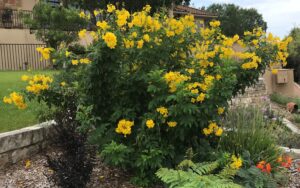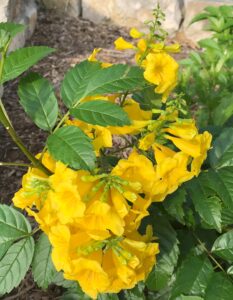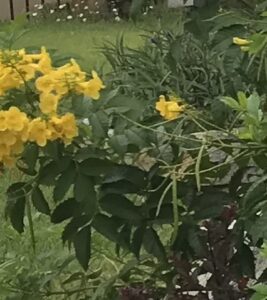Give Yourself a ‘Gold Star’

The showy blooms of Gold Star Esperanza grab the attention of pollinators and humans alike!
Gold Star Esperanza (Tecoma stans ‘Gold Star’) is a subtropical Texas native. It’s a reliable perennial in USDA Hardiness Zone 9. You might also know this showy plant as ‘yellow bells’ or ‘hardy yellow trumpet. The ‘Gold Star’ variety is the most prolific flowering variety that is “a must” for a Central Texas gardener. It is a fast-growing shrub that can reach 4-5 feet tall with similar width. The actual size is responsive to the growing conditions and is a wonderful accent plant in a container. Esperanza blooms in large clusters of golden yellow bell-shaped flowers persisting from early summer until the first frost. The glossy green foliage provides an excellent background for the summer-long color. This perennial is Austin-area tough – heat and drought-tolerant, requires full sun, needs well-drained soil, and is highly pest resistant. In fact, it thrives in our alkaline soils and is an Earth-Kind selection.
Gold Star Esperanza Plant Specifications at a Glance
- Exposure: Full sun (will tolerate afternoon shade)
- Size: Height – 4-6 feet.
- Plant Type: Summer perennial, or woody shrub depending upon the severity of winter temperatures.
- Planting time: Spring, after the threat of a freeze has passed.
- Soil type: Extremely easy to grow in alkaline to acidic, well-drained soils.
- Suggested uses: Use Esperanza as a specimen or plant in groupings for a swath of color.
- Special notes: Plants tolerate very high temperatures and drought, but do not tolerate poorly drained soils; Water once a week during the hottest periods to promote blooms. Trimming the seed pods will enable continuous blooms.
Texas Tough – Esperanza Persists

Clusters of bell-shaped flowers provide nectar for bees, hummingbirds, and butterflies.
The Esperanza is Texas Tough. Mine survived the 2019 fall rains, the 2021 “Snowmageden”, the 2022 drought and the 2023 winter freeze. This low maintenance shrub requires little care. Keep it tidy with an annual trimming of dead wood back to 6-8” from the ground. Shaping is not necessary, just trim it back when needed. This fast-growing shrub will emerge from a few sticks in February to a blooming shrub by late May.
Esperanza is a popular selection for a hedge, specimen, or in conjunction with other pollinator-friendly plants to attract wildlife all summer long. While smaller mammals ignore the Esperanza, during times of extreme drought, you might have a deer sample on the newly sprouted stems in early spring. But once the growth begins in earnest, the deer leave the plant alone to exhibit its summer show. You know it’s an easy-to-care-for plant when you see it used in parking lot landscapes.
Propagation Is Easy
Esperanza is easy to propagate by seeds or cuttings. During the blooming season, slender seed pods develop, which look like slender green beans. While a few seeds are desired, removing the pods will refocus the plant’s energy to provide the long bloom season. For the seeds you want to keep, allow the pods to turn brown and watch for the pod to split open and release the seeds. Seeds can be dried and stored in a cool, dry place to be used the next spring for propagation.

Seed pods look like slender green beans.
If you allow some of the seed pods to remain on the plant, you won’t be surprised to see a few ‘volunteers’ sprouting up the following spring. I prefer to allow some seeds to drop and pick out the sprouted new plants to pot and give away as gifts, or to plant in another worthy spot for new color. If starting from seed, place two seeds in each pot about an 1/8-inch deep and mist slightly to keep the soil moist, but not soggy. Germination should occur in two to three weeks.
Take Cuttings Mid-Spring to Early Summer
To start a plant from a cutting, take the cutting from the top of a stem so it’s pliable and green (soft-wood cutting). Propagating in mid-spring to early summer is best to obtain the soft-wood cutting before the new growth turns to hard-wood. Consistent with cutting propagation, cut at least two nodes in length and remove all leaves but the top two to three. A node is the area where leaves have emerged from the stem. Place the cutting in a well-draining medium, keep moist (not soggy), and store in indirect sun. Within two weeks, you should see a new leaf budding out, which is the sign that roots have established. Once new leaves are developing, begin to expose the plant to greater levels of sun (harden-off) before moving to it’s new home.
What is a Texas Superstar plant?
The Texas Superstar® program was created by horticulturists to identify and select plants that can be grown across the state of Texas with high confidence in the quality and reliability of the plant. Selections for the program are based upon observations made at replicated plots and demonstration trials across the state and final selection is made by the Texas Superstar® Executive Board.
Additional Resources
About Yvonne Schneider

Yvonne was a 35+year veteran in the computer and information technology industry when she retired and moved from Houston to the Austin area. In 2018, Yvonne certified as a Travis County Texas Master Gardener to follow her passion for gardening and volunteering within the community. She has spent 20+ years enjoying gardening and working with bulbs and perennials. She now tackles the challenges presented by the Austin area wildlife, drought, and limestone soil.

